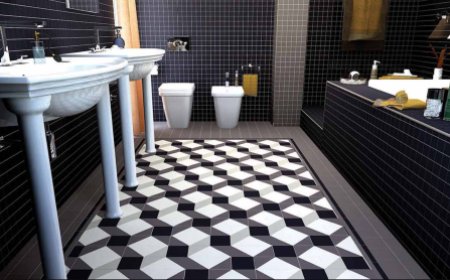How to Find Rooftop Views in New Orleans
How to Find Rooftop Views in New Orleans New Orleans is a city of layered beauty—where jazz spills from alleyways, historic facades glow under golden hour, and the Mississippi River winds like a silver ribbon through the heart of the French Quarter. But beyond the cobblestone streets and wrought-iron balconies lies another dimension of the city’s charm: the rooftop view. Whether you’re a photograp
How to Find Rooftop Views in New Orleans
New Orleans is a city of layered beauty—where jazz spills from alleyways, historic facades glow under golden hour, and the Mississippi River winds like a silver ribbon through the heart of the French Quarter. But beyond the cobblestone streets and wrought-iron balconies lies another dimension of the city’s charm: the rooftop view. Whether you’re a photographer chasing the perfect silhouette of the St. Louis Cathedral at dusk, a traveler seeking quiet solitude above the bustle, or a local looking for a new vantage point to appreciate your home, discovering rooftop views in New Orleans is both an art and a science. These elevated perspectives offer more than just scenery—they reveal the city’s spatial rhythm, architectural heritage, and cultural soul. Finding them requires more than a Google search; it demands curiosity, local knowledge, and strategic exploration. This guide will walk you through every step to uncover the city’s hidden rooftop gems, from public-access terraces to exclusive hotel balconies, and equip you with the tools, best practices, and real-world examples to make your quest successful.
Step-by-Step Guide
Finding rooftop views in New Orleans isn’t about luck—it’s about methodology. Follow this structured, seven-step process to systematically identify, access, and enjoy the best elevated perspectives the city has to offer.
Step 1: Define Your Purpose
Before you begin scouting, ask yourself: Why are you seeking a rooftop view? Are you looking for panoramic cityscapes, riverfront sunsets, historic architecture framed against the sky, or simply a quiet place to relax with a drink? Your goal will determine where to focus. For example, if you want unobstructed views of the French Quarter, prioritize locations in the Central Business District or along the riverfront. If you’re drawn to the quiet elegance of Garden District mansions, seek out rooftop access points in Uptown. Clarifying your intent helps filter out irrelevant options and saves time.
Step 2: Study the City’s Topography
New Orleans is famously flat, but subtle elevation changes exist. The city rises slightly from the river toward the back of the French Quarter and along the higher ground of the Garden District. Use topographic maps—available through the Louisiana Geological Survey or Google Earth’s 3D terrain view—to identify areas where buildings are likely to be taller or where natural elevation supports rooftop visibility. Look for clusters of mid-rise buildings (4–8 stories) near the Mississippi River, especially between Bourbon Street and the river, and along St. Charles Avenue. These zones are prime real estate for rooftop terraces.
Step 3: Identify Buildings with Rooftop Potential
Not every tall building has public or accessible rooftop space. Focus on the following building types:
- Historic hotels – Many boutique hotels in the French Quarter and Marigny built in the early 20th century feature rooftop gardens or terraces as original architectural elements.
- Restaurants and bars – Rooftop dining and drinking venues are increasingly popular. Look for establishments with “rooftop” or “skyline” in their names.
- Apartment complexes – Some newer developments in the Warehouse District and Bywater include shared rooftop decks for residents. While not public, they may host events open to visitors.
- Commercial buildings – Office towers with rooftop lounges or event spaces sometimes open during special occasions or for private bookings.
Use Google Maps’ Street View to virtually “walk” streets like Royal Street, Chartres Street, and Decatur Street. Look for staircases leading upward, glass-enclosed structures on rooftops, or signs indicating “Rooftop Bar” or “Terrace.”
Step 4: Leverage Online Directories and Review Platforms
Platforms like Yelp, TripAdvisor, and Instagram are invaluable. Search for keywords: “New Orleans rooftop bar,” “best rooftop view New Orleans,” “French Quarter rooftop,” or “sunset terrace New Orleans.” Filter results by recent reviews (within the last 6 months) to ensure accessibility. Pay attention to photos uploaded by users—look for angles showing skyline views, river reflections, or the iconic cathedral dome. Read comments about access policies: Is there a cover charge? Do you need to be a guest? Are reservations required? Some venues may not advertise rooftop access on their websites but mention it in reviews.
Step 5: Visit During Optimal Lighting Conditions
Timing matters. The best rooftop views are often experienced during “golden hour”—the hour after sunrise or before sunset. Light during these times enhances textures, casts long shadows across rooftops, and turns the river into a mirror. Plan visits between 5:30 PM and 7:00 PM in spring and summer, or 4:30 PM to 6:00 PM in fall and winter. Avoid midday; harsh sunlight flattens contrast and makes photography difficult. Also consider weather: clear days after rain offer the clearest visibility and the most vibrant colors.
Step 6: Engage Locals and Experts
No digital tool replaces human insight. Strike up conversations with bartenders, hotel concierges, taxi drivers, or bookstore clerks. Ask: “Where’s your favorite spot to see the city from above?” Locals often know of hidden access points—like a back staircase at a closed-down speakeasy now used as a private event space, or a rooftop garden at a church that opens during festivals. Join local Facebook groups like “New Orleans Hidden Gems” or “NOLA Rooftop Enthusiasts.” These communities regularly share photos, tips, and even event announcements for rooftop pop-ups.
Step 7: Respect Access Rules and Etiquette
Many rooftop views are on private property. Never trespass. If a rooftop is attached to a hotel or restaurant, purchase a drink or meal to gain access. If it’s a residential building, assume it’s off-limits unless explicitly stated otherwise. Some venues require reservations weeks in advance, especially during Mardi Gras or Jazz Fest. Always dress appropriately—some rooftop bars enforce smart-casual dress codes. And remember: noise, littering, and disruptive behavior can result in closures. Respect the space, and you’ll be welcomed back.
Best Practices
Successfully discovering rooftop views in New Orleans isn’t just about finding them—it’s about experiencing them responsibly and sustainably. Follow these best practices to ensure your adventures are safe, ethical, and rewarding.
1. Prioritize Safety Over Scenery
Some rooftops may lack proper railings, lighting, or maintenance. Avoid climbing fences, scaling fire escapes, or entering unmarked buildings. If a rooftop feels unsafe or poorly lit, leave. New Orleans’ humid climate can make metal surfaces slippery, and older structures may have hidden structural weaknesses. Always choose venues with clear entry points and visible security.
2. Use Technology Responsibly
Drone usage is heavily restricted in New Orleans due to FAA regulations and proximity to airports and historic districts. Never fly a drone over rooftops or crowded areas. Instead, use your smartphone’s panorama mode or a compact camera with a wide-angle lens to capture expansive views. Apps like PhotoPills or Sun Surveyor can help you plan your visit by showing sun and moon paths relative to your target location.
3. Time Your Visits Around Events
Major events like Mardi Gras, French Quarter Festival, and Jazz Fest bring massive crowds. Rooftop venues may be booked solid or temporarily closed for private functions. Avoid visiting during peak event weekends unless you’ve secured a reservation months in advance. Conversely, consider visiting during shoulder seasons (April–May or September–October) when the weather is ideal, crowds are thinner, and many venues offer special rooftop events.
4. Document Ethically
Photography is encouraged, but be mindful of privacy. Avoid photographing guests or residents without consent, especially in residential areas. If you’re shooting from a rooftop that overlooks private balconies or windows, use a telephoto lens to maintain distance. Respect “No Photography” signs—they’re often there for legal or cultural reasons.
5. Support Local Businesses
Most accessible rooftop views in New Orleans are tied to small, independent businesses. A $12 cocktail or $20 appetizer may seem steep, but it sustains the livelihood of the staff who maintain the space and preserve its beauty. Tip generously, leave positive reviews, and recommend the spot to others. Your patronage helps keep these views alive for future visitors.
6. Be Weather-Aware
New Orleans experiences sudden thunderstorms, especially in summer. Always check the forecast before heading out. Rooftop terraces can become dangerous during high winds or lightning. If rain is predicted, bring a light jacket—many rooftops have covered sections, but open-air decks can flood quickly. Humidity can also make metal railings hot to the touch, so avoid touching surfaces during midday heat.
7. Share Knowledge, Not Locations
Some of the most beautiful rooftop views are kept quiet by locals to preserve their serenity. If you discover a hidden gem, don’t post its exact coordinates or address on public forums. Instead, describe the general area (“near the intersection of Magazine and 17th”) or mention the building’s architectural style. This protects the spot from overcrowding and potential vandalism while still guiding others.
Tools and Resources
Equipping yourself with the right tools makes the search for rooftop views efficient and enjoyable. Below are curated digital and physical resources to aid your exploration.
Digital Tools
- Google Earth Pro – Use the 3D building layer and historical imagery to analyze rooftop structures over time. You can measure distances between buildings and simulate sun angles.
- Google Maps Street View – Navigate streets virtually to spot stairwells, signs, or rooftop features. Toggle between different years to see if a rooftop terrace was added or removed.
- Yelp and TripAdvisor – Search filters for “rooftop,” “view,” and “outdoor seating.” Sort by “Top Rated” and read photo reviews.
- Instagram – Search hashtags:
NOLARooftop, #FrenchQuarterRooftop, #NewOrleansSkyline. Click on geotags to find exact locations.
- PhotoPills – A powerful app for photographers that shows the position of the sun, moon, and stars relative to your location. Ideal for planning sunset shots.
- OpenStreetMap – A community-driven map that sometimes includes details not found on Google Maps, such as private access points or building heights.
Physical Resources
- New Orleans City Map (printed) – Available at tourist centers or bookstores like Garden District Book Shop. Look for maps that label building heights or historic districts.
- “New Orleans Architecture” Series – Books by the Historic New Orleans Collection provide detailed floor plans and architectural histories of key buildings, many of which include rooftop features.
- Local Tour Guides – Companies like NOLA Tours and French Quarter Phantoms offer specialized “Hidden Views” walking tours that include rooftop access.
- Hotel Concierge Books – Many upscale hotels keep a booklet of local recommendations. Ask for “off-the-beaten-path views” or “quiet spots with a skyline.”
Community Resources
- Friends of the Cabildo – A preservation group that occasionally hosts rooftop access events at historic buildings.
- New Orleans Film Society – Hosts outdoor rooftop film screenings during summer months, offering free public access to elevated spaces.
- Local Universities – Tulane and Loyola architecture departments sometimes open campus buildings with rooftop terraces to the public during open house events.
Real Examples
Theory is useful, but real-world examples ground your search. Here are five verified rooftop view locations in New Orleans, each with unique characteristics and access details.
1. The Rooftop Bar at The Roosevelt New Orleans
Perched atop the historic Roosevelt Hotel on St. Charles Avenue, this terrace offers sweeping views of the Garden District and the river. The space features vintage chandeliers, lush greenery, and an open-air bar. Access is granted to hotel guests and diners at the on-site restaurant, The Sazerac Bar. No cover charge for drinks, but reservations are strongly recommended. Best for: sunset cocktails with live jazz. Tip: Request a table near the east railing for direct views of the river and the Crescent City Connection bridge.
2. The Carousel Bar & Lounge – Rooftop Terrace (Seasonal)
While the famous Carousel Bar itself is indoors, its parent establishment, The Hotel Monteleone, occasionally opens a rooftop terrace during Mardi Gras and Jazz Fest. Located above the hotel’s main entrance on Royal Street, it offers panoramic views of the French Quarter’s rooftops and the distant cathedral. Access is limited to hotel guests and those with reservations for special events. Check the hotel’s website monthly for announcements. Best for: festival-goers seeking a quiet escape from Bourbon Street chaos.
3. The High Ground Rooftop Bar (Bywater)
A hidden gem in the Bywater neighborhood, this small, locally-owned bar occupies the top floor of a converted warehouse. The rooftop is open-air, with string lights and mismatched furniture. The view includes the Mississippi River, the Industrial Canal, and the distant skyline of the CBD. No reservation needed, open daily from 4 PM. Drinks are affordable, and the vibe is casual. Best for: locals and off-the-beaten-path seekers. Note: The staircase is narrow and steep—wear comfortable shoes.
4. The Rooftop at The Ace Hotel New Orleans
Located in the former U.S. Customs House in the Warehouse District, The Ace’s rooftop is a minimalist, modern space with panoramic views of the river, the Superdome, and the city’s historic rooftops. Open to the public with no minimum spend, though drinks and food are available. The terrace is popular after work hours and on weekends. Best for: urban photography and night views. Tip: Visit on a clear night—streetlights below create a grid of golden dots that mirror the stars above.
5. The Church Street Rooftop Garden (Private Access via Event)
At 825 Church Street, a converted 19th-century church now hosts art exhibitions and rooftop garden parties. The rooftop garden, planted with native Louisiana flora, offers one of the most tranquil views in the city—looking down on the French Quarter’s red-tiled roofs and up at the sky. Access is only available during scheduled events, which are announced on the church’s Instagram (@churchstreetnola). Events are free to attend but require RSVP. Best for: quiet contemplation and nature lovers. Note: This is not a bar—no alcohol is served, and visitors are asked to remain respectful of the sacred space.
FAQs
Can I access rooftop views in New Orleans for free?
Yes, but options are limited. Some hotels and restaurants offer free access if you purchase a beverage. The Ace Hotel’s rooftop allows free entry without a purchase. Certain public events, like rooftop film nights hosted by the New Orleans Film Society, are also free. However, most high-demand rooftop views require spending at the venue to cover maintenance, security, and staffing.
Are rooftop views open year-round in New Orleans?
Most rooftop venues operate seasonally, typically from March through October, due to heat and humidity. Some, like The Roosevelt’s rooftop, are open year-round with heaters and covered areas. Always check the venue’s website or call ahead during winter months to confirm hours.
Do I need to make a reservation for rooftop views?
Highly recommended, especially on weekends and during festivals. Popular spots like The Roosevelt and The Ace Hotel often fill up by 5 PM on Friday and Saturday nights. For smaller venues like The High Ground, reservations are not required but arriving before 6 PM ensures a good spot.
Can I bring my own food or drinks to a rooftop view?
No. Most rooftops prohibit outside food and beverages for liability and licensing reasons. Bringing your own drinks can result in being asked to leave. Respect these rules to help preserve access for everyone.
Are rooftop views accessible for people with mobility challenges?
Accessibility varies. Many older buildings lack elevators to rooftops. The Roosevelt and The Ace Hotel both have elevator access. Smaller venues like The High Ground may require climbing stairs. Always call ahead to confirm accessibility options before visiting.
What’s the best time of year to photograph rooftop views in New Orleans?
Spring (March–May) and fall (September–November) offer the best combination of mild temperatures, low humidity, and clear skies. Summer can be hazy due to humidity, and winter may bring overcast conditions. For vibrant colors, visit during the azalea bloom in March or the fall foliage in late October.
Is it safe to take photos from rooftops?
Yes, if you’re on a permitted, public-access rooftop. Never lean over railings or stand on ledges. Use a tripod only if allowed—some venues restrict equipment due to space or safety concerns. Always be aware of your surroundings and avoid blocking walkways.
What should I wear to a rooftop view in New Orleans?
Dress for the weather and the venue. For upscale rooftops like The Roosevelt, smart casual is expected—no flip-flops or athletic wear. For casual spots like The High Ground, jeans and a nice shirt are fine. Always bring a light jacket—evenings can be cool, even in summer. Closed-toe shoes are recommended for uneven surfaces and stairs.
Can I host a private event on a rooftop in New Orleans?
Many rooftop venues offer private rentals. Contact venues directly for pricing and availability. Popular options include The Roosevelt, The Ace Hotel, and The Hotel Monteleone. Expect minimum spend requirements and advance booking—often 4–8 weeks for weekend events.
What if a rooftop view I found online is closed?
It’s common. Rooftop bars and terraces in New Orleans open and close frequently due to seasonal demand, ownership changes, or permitting issues. If a venue is closed, check its social media for updates or ask locals for alternatives. Often, a new rooftop will emerge nearby—New Orleans’ hospitality scene is dynamic and ever-evolving.
Conclusion
Finding rooftop views in New Orleans is more than a tourist activity—it’s a way of connecting with the city on a deeper, more intimate level. From the grandeur of historic hotel terraces to the humble charm of a hidden garden above a Bywater warehouse, each elevated perspective tells a story: of resilience, beauty, and the quiet joy of seeing the familiar from an unfamiliar angle. The process of discovery—using maps, engaging with locals, respecting boundaries, and timing your visit with care—is as rewarding as the view itself. This guide has equipped you with the tools, techniques, and real-world examples to navigate this pursuit with confidence and respect. Remember: the best views aren’t always the most famous. Sometimes, they’re the ones you find by accident, after asking a bartender for a quiet spot, or by waiting just a few minutes past sunset as the city lights flicker on. New Orleans rewards patience. It rewards curiosity. And above all, it rewards those who seek its heights with humility and heart. So go up. Look out. And let the city reveal itself to you, one rooftop at a time.




















